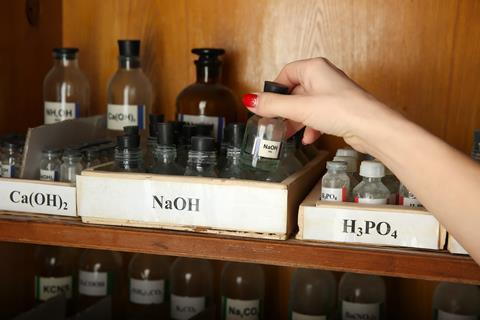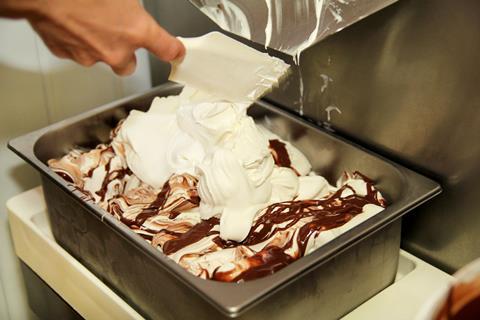Meera Senthilingam
This week, some chemical lies. Here's Brian Clegg:
Brian Clegg
Some chemical compounds are simply known by their formulaic name - carbon dioxide, for example. But where a compound has been widely used for many years, it tends to have familiar names that eclipse the standard formulation. In some cases these names are comfortably used in the chemical community. No one is going to raise an eyebrow if you refer to H2O as water. But other traditional names now seem slightly quaint and definitely old fashioned. This is certainly the case with caustic soda, also know as lye (that's L-Y-E).
What we're dealing with here is sodium hydroxide, the strongest alkali we are likely to come across in everyday use. This powerful base is a simple ionic compound of sodium with a hydroxide ion - a negatively charged combination of single oxygen and hydrogen atoms. Sodium hydroxide is extremely corrosive and needs to be handled with care.

This compound was used long before it was identified, with recipes for the manufacture of a weak solution (by percolating vegetable ashes with water) going back to the ancient Egyptians and the Babylonians. There is a mix of lye produced this way and olive oil, used to produce a common product, described on a clay tablet that is around 4800 years old. At the time, of course, no one had a clue what they were using. A clear identification of the nature of the substance had to wait for Humphrey Davy's discovery of the element sodium, which he produced by electrolysing molten sodium hydroxide in 1807.
Sodium hydroxide itself is a white solid at room temperature, with a waxy consistency. It is usually produced as pellets or flakes and needs to be stored in airtight containers as it is hygroscopic - it takes in water from the air to dissolve into a mess in the bottom of the jar. When dissolved intentionally in water it does so very easily, giving off a fair amount of heat.

The existence of the common names for this compound is a first clue that this is a substance with a wide range of uses. In the home, sodium hydroxide is often used to unblock drains because of its interaction with fats, likely to cause the blockage, by converting them into a soluble material. The same process is used in industrial cleaning, where a hot sodium hydroxide solution is used to degrease machinery and storage tanks.
We'll come back to the material made from fats by sodium hydroxide because it is the basis of the industrial process that made caustic soda an essential ingredient. There certainly needs to be some industrial use of the substance, as blocked drains can hardly account for the 50 to 60 million tonnes of the compound the world consumes every year. Most sodium hydroxide is produced by electrolysing sodium chloride solution, giving off chlorine and hydrogen and leaving sodium hydroxide in solution.
Back with those Ancient Egyptians and Babylonians we see the first significant use of sodium hydroxide. They discovered, presumably accidentally when trying to wash away ash, that water that had run through vegetable ashes took on a specific property. It changed oil or fat into something different, something that would become known as soap. The process was remarkable in itself, because it took a substance that wouldn't dissolve in water and made it soluble - but more so with the (presumably again accidental) discovery that this new product helped get things clean.

At the chemical level, in its simplest form without all the smells and subtleties, a soap is a salt of a fatty acid. Oils and fats contain mixtures of fatty acids, bonded together with the molecule glycerol to form a triglyceride. The sodium hydroxide breaks up the triglyceride and converts the acids into sodium salts, producing the likes of sodium tallowate and sodium palmitate. These salts act as surfactants, substances that reduce the surface tension in liquids. They form tiny balls around particles of grease, stopping the grease from being hydrophobic and allowing it to dissolve and be carried away by water.
Modern soap making processes, though still based on a combination of a strong alkali like sodium hydroxide and oils or fats, are unlikely to stick with a straight sodium hydroxide and fat mix, as the soap produced is quite harsh. Any sodium hydroxide left over can have a catastrophic effect, as it dissolves oils and fats in skin and flesh and leaves deep burns. At the extreme, sodium hydroxide will dissolve flesh entirely, and has been used to dispose of road kill (and murder victims). Practically all the early soaps (often called 'lye soap') were rough and left the skin red.

Rather unnervingly, the destructive capability of sodium hydroxide is now used in various industrial food processes, from removing fruit skin to producing ice-cream. You are also likely to find sodium hydroxide at work in paper mills. When paper is made from wood pulp, it starts with a mix of the substances lignin and cellulose, bonded together. The sodium hydroxide breaks down the bonds, allowing the separation of the cellulose that will be used to form the paper. It can also be used to bleach the wood pulp to produce a white result.
If we look back into the origins of the word 'lye' the oldest name for sodium hydroxide, it comes from an old English word meaning 'wash stuff', and 'lye' was used as a term for strong soap from the 13th century onwards. It's a rare example of putting a lye to good use.
Meera Senthilingam
Indeed. So, in the chemical industry, a lye can prove quite useful. That was Brian Clegg, with the soapy-clean chemistry of sodium hydroxide. Now, next week, a puff of paralysis.
Simon Cotton
Tetrodotoxin, abbreviated to TTX, is obtained from the fugu fish, also known as the pufferfish, because when it is threatened it inflates its body to several times normal size.
Symptoms start within a few minutes of ingesting it; they begin with tingling or numbness of the lips and tongue. It spreads to other parts of the face, then more and more nerves and muscles are paralysed; the victim, who may remain fully conscious, becomes unable to move until they die of asphyxiation.
Meera Senthilingam
And to find out just how the toxin has this effect, as well as how the pufferfish is safely served as a japanese delicacy, join Simon Cotton in next week's Chemistry in its element. Until then, thank you for listening. I'm Meera Senthilingam.













No comments yet